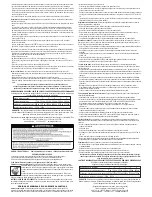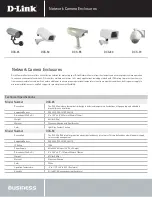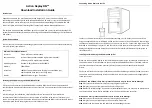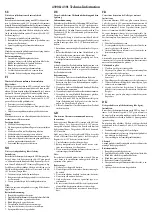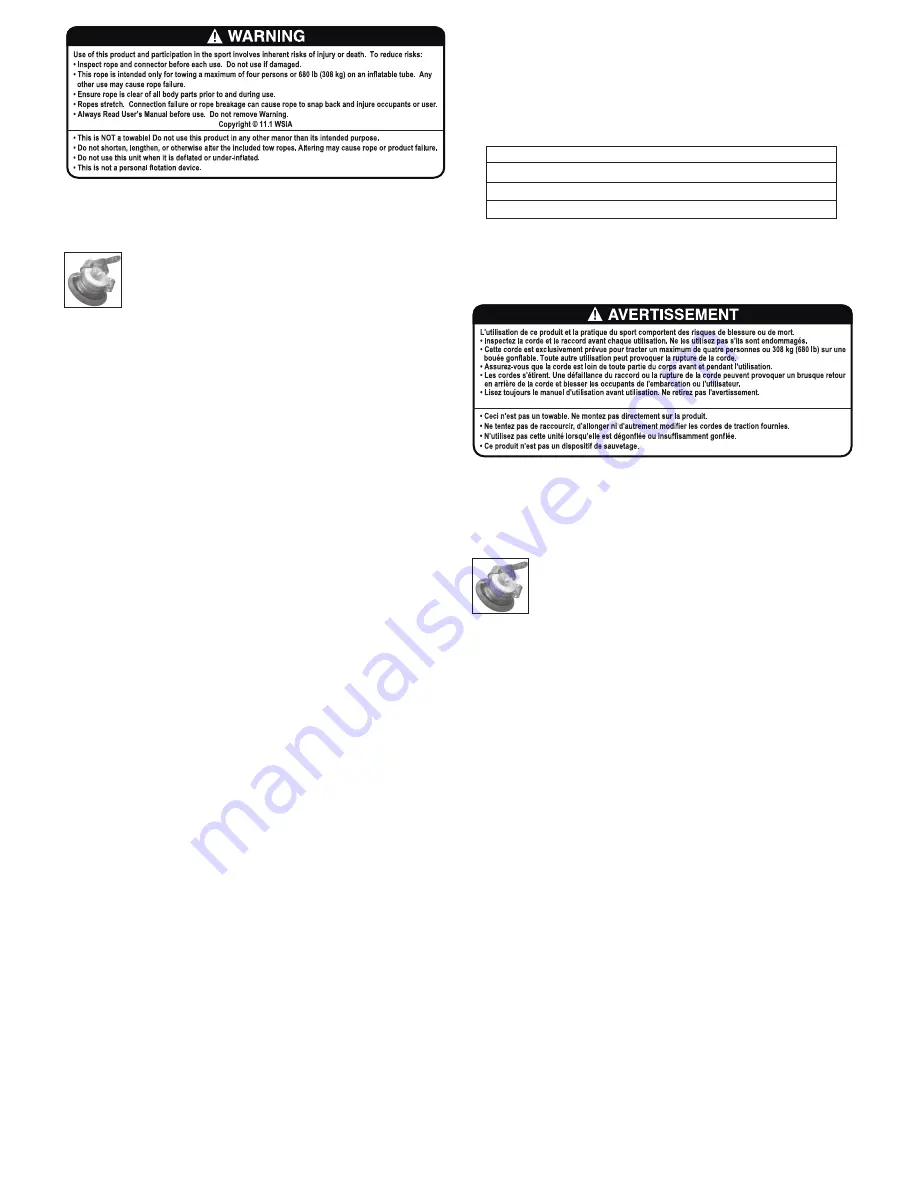
AHBOB-1 BOOSTER BALL Bouées tractable 1 à 4 utilisateurs- Résistante aux ruptures 1,860 kg
ASSEMBLAGE ET INSTALLATION:
1. Localisez la valve de la chambre à air principale (sous le cache de valve de l’enveloppe en nylon).
2. Gonflez la bouée jusqu’à ce sa toile de revêtement soit parfaitement tendue.
3. Fermez complètement la valve. Refermez le couvercle de la valve (fermeture éclair).
Votre bouée 4 k Booster Ball™ est équipée de la valve de sécurité illustrée ci-dessous :
Valve de sécurité pour gonflage rapide
- Elle se retire pour le gonflage/dégonflage rapide, puis peut être
réintégrée complètement dans le tube. Pour fermer correctement la valve pour gonflage
rapide, il suffit de visser fermement sa partie inférieure dans la base. Lors du gonflage,
dévissez uniquement le bouchon ou la partie supérieure de la valve. Gonflez la bouée en
raccordant le tuyau de votre pompe à l’ouverture supérieure de la valve.
Les performances de ce produit ne peuvent être optimales que si le gonflage est approprié.
Lorsqu’elle est correctement gonflée, la chambre à air est conçue pour s’ajuster parfaitement à
sa toile de revêtement en nylon, c’est-à-dire que cette dernière ne doit présenter que très peu de plis.
MODE D’EMPLOI DU PRODUIT:
Trouvez la section de corde attachée à l’extrémité de la « Booster Ball »
avec bouchon de valve noir. Attachez-la au point de remorque du bateau. Attachez l’autre corde au point de
remorque du remorquable.
CODE DE SÉCURITÉ DES SPORTS NAUTIQUES
Avant de vous mettre à l’eau:
Il est recommandé de suivre un cours de ski ou de surf avant l’utilisation. Les
instructions décrivent les consignes de sécurité générales et les techniques correctes de ski ou de surf, qui
peuvent réduire les risques de blessures. Pour en savoir plus sur les écoles de ski et de surf, contactez votre
concessionnaire ou votre association ou club de ski local.
• Informez-vous sur les lois fédérales, nationales et locales en vigueur dans votre région.
• Si vous ne connaissez pas bien une voie navigable, demandez à quelqu’un qui la connaît de vous indiquer les
dangers cachés ou les lieux à éviter.
• Que vous prévoyez d’être dans l’embarcation ou de skier derrière, il est important de porter un gilet de
sauvetage bien ajusté, homologué par l’organisme de votre pays, USCG Type III, ISO, etc.
• Inspectez tous les équipements avant chaque utilisation, vérifiez les fixations, les dérives, la bouée, le
raccord, la corde de traction et l’équipement de flottaison. Ne les utilisez pas s’ils sont endommagés.
Sécurité de l’embarcation:
Un conducteur expérimenté et responsable est la meilleure garantie de sécurité
sur un bateau.
• Ne jamais manoeuvrer l’embarcation, skier ou surfer sous l’emprise d’alcool ou de drogue.
• Utilisez uniquement du ballast liquide et des personnes pour le poids additionnel.
• Ne dépassez jamais les limitations de poids ou de passagers de l’embarcation.
• Ne laissez jamais des passagers s’accrocher à l’extérieur de l’embarcation ou du dispositif tracté ou s’asseoir
sur les plats-bords ou en-dehors de la zone prévue pour s’asseoir.
• Ne laissez jamais l’eau dépasser le niveau de la proue ou des plats-bords de l’embarcation.
• Une distribution irrégulière du poids ou un poids additionnel peuvent compromettre la manoeuvre de
l’embarcation.
Monoxyde de carbone:
les gaz d’échappement du moteur de l’embarcation contiennent du monoxyde de
carbone (CO) qui est incolore, inodore et toxique. Une exposition excessive au CO peut causer de graves
blessures ou la mort. Suivez ces conseils pour éviter toute blessure.
• Ne vous faites jamais traîner en vous tenant à la plate-forme arrière ou directement derrière l’embarcation.
C’est là que l’on trouve du CO.
• Ne vous asseyez pas sur le tableau arrière de l’embarcation ou sur la plate-forme d’embarquement pendant
que le moteur tourne.
• Vérifiez que le moteur est correctement réglé et qu’il tourne correctement. Un moteur mal réglé produit un
excès de gaz d’échappement et de CO.
• Si vous sentez les gaz d’échappement du moteur, ne restez pas dans cette position.
• Visitez le site des Garde-Côtes américains: www.uscgboating.org pour en savoir plus sur la façon de vous
protéger et de protéger les autres des dangers du CO.
Cordes de traction:
Les cordes de traction sont disponibles en différentes longueurs et résistances pour
différentes activités. Vérifiez que la corde que vous utilisez est adaptée à la pratique du ski ou du surf et qu’elle
est en bon état.
• N’utilisez jamais une corde qui est effilochée, nouée, ou qui se défait ou est décolorée par l’utilisation ou
par l’exposition au soleil. Si une corde se casse pendant l’utilisation, elle risque de revenir vers le skieur/
rider tracté ou dans l’embarcation où elle peut heurter les passagers. Remplacez les cordes de traction qui
présentent des signes de détérioration.
AHBOB-1 BOOSTER BALL 4 Rider Tow Rope - 4100 lb. Break Strength
ASSEMBLY AND INSTALLATION:
1. Locate the valve on the main tube (Under valve cover on the nylon cover).
2. Inflate main tube until it is firm and the cover is wrinkle free and taut.
3. Close valve completely. Close the valve cover by zipping it shut.
Your 4K Booster Ball is equipped with the following type of inflation valve
:
Speed Safety Valve:
Pulls out for fast inflation/deflation, then can be pushed in flush
with the tube. Secure the valve by firmly fastening the bottom portion of the valve into the
base. To inflate, open cap or top portion of the valve. Using the hose from your inflator,
inflate through the top opening of the valve.
Proper inflation is the key to the optimum performance of this product. The tube is designed to fit snugly
inside the cover, and there should be very few wrinkles in the cover when the tube is properly inflated.
PRODUCT INSTRUCTIONS:
Find the rope section attached to the end of the Booster Ball with black
valve cover. Attach it to the tow point on boat. Connect the other rope to the towable’s tow point.
WATERSPORTS SAFETY CODE
Before you get in the water:
Skiing or riding instruction is recommended before use. Instruction will
teach general safety guidelines and proper skiing or riding techniques, which may reduce your risk of injury.
For more information on skiing or riding schools, contact your dealer, Association, or local ski club.
• Know the federal, state and local laws that apply to your area.
• If you are not familiar with a waterway, ask someone who is, to tell you about any hidden dangers or
things to avoid.
• Whether you plan to be in a watercraft, or skiing/riding behind one it is important you are wearing a
properly fitted life jacket (PFD) approved by your country’s agency, USCG Type III, ISO, etc.
• Inspect all equipment prior to each use, check bindings, fins, tube, attachment, tow rope and flotation
device. Do not use if damaged.
Watercraft Safety:
A knowledgeable and responsible driver is the most important safety device on any
watercraft.
• Never operate a watercraft, ski or ride under the influence of alcohol or drugs.
• Only use water ballast and people for additional weight.
• Never exceed the passenger or weight limitations of the watercraft.
• Never allow passengers to hang outside the watercraft or towed device or sit on the gunwales or
anywhere outside of the normal seating area.
• Never allow water to overflow the bow or gunwales of the watercraft.
• Uneven weight distribution or additional weight may affect the handling of the watercraft.
Carbon Monoxide:
The exhaust from the engine on a watercraft contains Carbon Monoxide (CO) which
is a colorless, odorless and poisonous gas. Excessive exposure to CO can cause severe injury or death.
Follow this advice to avoid injury.
• Never “Platform Drag” by holding onto the boarding platform or be dragged directly behind the watercraft.
This is where CO will be.
• Do not sit on the watercraft transom or boarding platform while the engine is running.
• Make sure the engine is properly tuned and running well. An improperly tuned engine produces excessive
exhaust and CO.
• If you smell engine exhaust do not stay in that position.
• Go to the United States Coast Guard’s website: www.uscgboating.org for more information on how to help
protect yourself and others from the dangers of CO.
Tow Ropes:
Tow ropes come in different lengths and strengths for different activities. Make sure any rope
you are using is suited for skiing or riding and that it is in good condition.
• Never use a rope that is frayed, knotted, unraveling or discolored from use or being left in the sun. If a
rope breaks while in use it can recoil at the skier/rider being towed or into the watercraft where it might
strike passengers. Replace tow ropes with any sign of damage.
• Never use a tow rope with elastic or bungee material to pull skiers or riders.
• Rope should be attached to the watercraft in an approved fashion with hardware designed for towing.
Refer to your watercraft manual for instructions on proper tow rope attachment.
• Always keep people and tow ropes away from the propeller, even when idling.
• If a tow rope should become entangled in a propeller, shut off engine, remove the key and put it in your
pocket before retrieving the rope.
• Tow ropes should be neatly stowed in the boat when not in use.
Preparing to ski or ride:
Always have a person other than the driver as an observer to look out for the
skier/rider.
• Be sure the driver is aware of the experience and ability level of the skier/rider.
• The driver, observer and skier/ rider need to agree on hand signals before skiing or riding. Signals should
include READY, STOP, SPEED UP, and SLOW DOWN.
• Start the engine only after making sure that no one in the water is near the propeller.
•
Turn the engine off when people are getting into or out of the watercraft, or in the water near the
watercraft.
• Always make sure the tow rope is not wrapped around anyone’s hands, arms, legs, or other parts of the
body.
• Start the watercraft and move slowly to remove slack until the tow rope is tight.
• When the skier/rider signals READY and there is no traffic ahead, take off in a straight line. Adjust the
speed according to the signals given by the skier/rider.
Skiing or Riding:
The watercraft and skier/rider should always maintain a sufficient distance from
obstacles so a skier/rider falling or coasting and/or watercraft will not encounter any obstacle.
• Do not use in shallow water or near shore, docks, pilings, swimmers, other watercraft, or any other
obstacles.
• Use only on water.
• Never attempt land or dock starts. This will increase your risk of injury or death.
• Always wear a properly fitted life jacket (PFD) approved by your country’s agency, USCG Type III, ISO,
etc.
• The faster you ski or ride, the greater your risk of injury.
• Never make sharp turns that may cause a slingshot effect on the skier/rider’s speed.
• Skier/Rider should be towed at an appropriate speed for their ability level.
Fallen skier or rider:
Falling and injuries are common in skiing or riding.
• Circle a fallen skier/rider slowly to return the tow rope handle or pick up the fallen skier/rider.
• Put the watercraft in neutral when near a fallen skier/rider.
• Always keep the fallen skier/rider in view and on the driver’s side of the watercraft.
• Display a red or orange skier-down flag to alert other vessels that a skier/rider is down.
The Warnings and practices in the Watersports Safety Code represent common
risks encountered by users. The code does not cover all instances of risk or danger.
Please use common sense and good judgment.
MAXIMUM NUMBER OF RIDERS, WEIGHT LIMIT & RECOMMENDED TOW ROPES
It is dangerous
to exceed the capacities listed below. Be sure to follow the WSIA rope recommendations.
WARRANTY-
This product is warranted to be free from defects in materials and workmanship for
90 days from the date of purchase. Damage due to misuse or improper care is excluded. This
warranty does not cover normal wear and tear. Keep your original receipt.
Please contact us if you have any questions on the proper selection, function, or safe use of this product.
Kwik Tek, Inc., 12000 E. 45th Ave., Unit 104, Denver, CO 80239
www.kwiktek.com 1-800-624-1297 kwiktek@airhead.com
Maximum number riders: 1 2 3 4 5 6
Maximum weight of riders: 170 lb 340 lb 510 lb 680 lb
850 lb 1020 lb
Tensile strength of tow rope: 1500 lb 2375 lb 3350 lb 4100 lb 6000 lb 6000 lb
Length of tow rope: 50 ft - 65 ft -------------------------------------------------------------------


